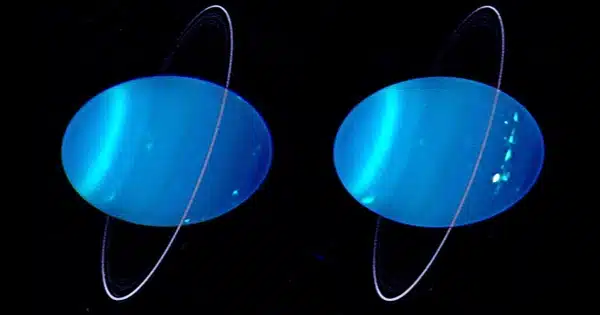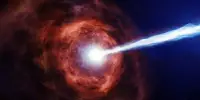The Planet’s Dramatic Rings and Dynamic Atmosphere are Highlighted in Webb’s Infrared Image: Uranus is an outlier in our solar system, orbiting the sun on its side and creating severe seasons. While the planet’s atmosphere seemed essentially featureless when the Voyager 2 probe arrived in 1986, later ground and space measurements have revealed chaotic storms.
Uranus was recently viewed by NASA’s James Webb Space Telescope, and the accompanying image shows a complex system of rings, as well as a brilliant polar cap and maybe storm clouds.
Webb Space Telescope Discovers Another Ringed Planet with New Uranus Image: Following in the footsteps of the Neptune image published in 2022, NASA’s James Webb Space Telescope has captured a magnificent image of Uranus, the solar system’s other ice giant. The new image depicts the planet’s spectacular rings as well as brilliant spots in its atmosphere. The Webb findings show the observatory’s remarkable sensitivity to the weakest dusty rings, which had previously only been photographed by two facilities: the Voyager 2 spacecraft as it sailed by the planet in 1986, and the Keck Observatory with superior adaptive optics.
Uranus, the seventh planet from the Sun, is distinctive: It turns 90 degrees away from the plane of its orbit, rotating on its side. Since the poles of the earth alternate between long stretches of uninterrupted sunshine and an equivalent interval of total darkness, this results in harsh seasons. (Uranus takes 84 years to orbit the Sun.) The northern summer of Uranus will occur in 2028; it is now late spring near the northern pole, which is visible here. In contrast, it was summer at the south pole when Voyager 2 traveled to Uranus. The south pole is currently hidden from view and facing the gloom of space on the planet’s “dark side.”
This infrared image from Webb’s Near-Infrared Camera (NIRCam) combines data from two filters at 1.4 and 3.0 microns, which are represented in blue and orange, respectively, in the image. In the resultant representative-color picture, the planet has a blue tint.
In visible wavelengths, Voyager 2’s camera revealed a virtually featureless blue-green orb. We observe greater detail with the infrared wavelengths and increased sensitivity of Webb, demonstrating how active Uranus’ atmosphere is.
A polar cap, or region of brightening at the pole facing the Sun, may be seen on the right side of the planet. These Webb data will aid scientists in unraveling the now unfathomable process behind this peculiar polar cap that appears on Uranus in the summer when the pole is exposed to direct sunlight and disappears in the fall. The polar cap’s slightly increased brightness in the middle was a startling feature that Webb uncovered. We may be able to notice this increased Uranus polar feature because Webb’s NIRCam is more sensitive and has longer wavelengths than other powerful observatories like the Hubble Space Telescope and Keck Observatory.
A second extremely brilliant cloud is observed near the planet’s left limb, and there is a bright cloud at the edge of the polar cap as well as a few fainter extended structures just beyond the border of the cap. Such infrared-spectrum clouds are common in Uranus and probably indicate the presence of storms.
The internal chemical composition of this planet qualifies it as an ice giant. Most of its bulk is considered to be made up of a tiny rocky core surrounded by a hot, dense fluid of “icy” substances like water, methane, and ammonia.
The planet Uranus, the other ice giant in the Solar System, has been captured in a breathtaking photograph by the James Webb Space Telescope. Both striking rings and brilliant structures in the planet’s atmosphere may be seen in the new image. With their remarkable sensitivity, the new Webb observations on Uranus can detect even the most minute dusty rings. The odd Uranus, the seventh planet from the Sun, spins at a nearly 90-degree angle from the plane of its orbit. Since the poles of the world alternate between 42 years of continuous sunshine and 42 years of total darkness, this results in odd seasons. (Uranus takes 84 years to orbit the Sun). The northern pole, which lies on the right side of this photograph, is currently in late spring; Uranus’ northern summer will occur in 2028.
11 of Uranus’ 13 recognized rings may be seen in this Webb picture. When they are near enough, some of these rings with Webb appear to merge into a bigger ring because they are so brilliant. Two are the fainter dusty rings that weren’t seen until the 1986 flyby by Voyager 2, including the diffuse zeta ring nearest to the planet, which is one of the nine rings considered to be the planet’s primary rings. Future Webb photos of Uranus are anticipated to reveal the two flimsy outer rings, which were seen with Hubble during the 2007 ring-plane crossing.
Many of Uranus’ 27 known moons, the majority of which are too tiny and dim to be visible here, were also photographed by Webb; the six brightest are noted in the wide-view image. Just two filters and a 12-minute exposure time were used to capture this image of Uranus. It is only the tip of what Webb is capable of when it comes to studying this enigmatic planet. More research on Uranus is now being conducted, and more is planned during Webb’s first year of science operations.
In its 2023–2033 Planetary Science and Astrobiology decadal study, the National Academies of Sciences, Engineering, and Medicine designated Uranus science as a priority in 2022.















